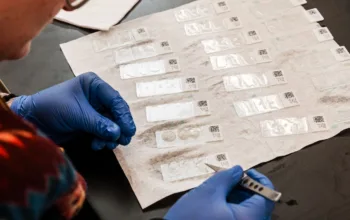
The travel ban ruling is the latest major consequence of his blockade of Merrick Garland.
Just minutes after the Supreme Court’s conservative majority upheld President Trump’s travel ban, Mitch McConnell’s campaign team tweeted a photo of him with Supreme Court Justice Neil Gorsuch.
— Team Mitch (@Team_Mitch) June 26, 2018
The message was obvious: Gorsuch’s confirmation made the difference in this case — and the Senate majority leader wanted to brag about his role in making that happen.
Indeed, again and again this month, the court’s conservative bloc has come together to make controversial, ideologically charged 5-4 rulings, with the liberals in dissent.
They mostly sided with the state of Texas in a racial gerrymandering lawsuit. They sided against California in a case regarding abortion opponents’ speech rights. They ruled that Ohio’s voter roll purges were legal. They backed credit card company American Express in a case with major antitrust implications. Today they upheld Trump’s travel ban. Tomorrow, they’re expected to deal a major blow to public sector unions, in the Janus v. AFSCME case.
If President Obama had gotten his Supreme Court nominee, Merrick Garland, confirmed after Antonin Scalia died in 2016, all of these cases would almost surely have turned out differently.
Scalia’s death under a Democratic president had the potential to be a turning point in American jurisprudence. Generally, justices try to time their retirements to ensure their successor will be appointed by a president of their preferred party. Replacing a hard-line conservative like Scalia with a Democratic appointee would have moved the court sharply to the left. What’s more, it would have given liberals their first Supreme Court majority in a remarkably long time — since the 1960s.
But McConnell pulled off quite the gambit to prevent that. It was only about an hour after the confirmation of Scalia’s death that he issued a statement declaring that the vacancy “should not be filled until we have a new president.”
When Obama did eventually nominate Garland, McConnell resolved that the Senate shouldn’t even hold hearings considering the nomination — and got his party to go along. Even when the ideologically murky Donald Trump became the GOP nominee presumptive, and Hillary Clinton looked strongly favored to win, McConnell stuck to his guns.
Now, the decisiveness of McConnell’s own intervention here can be overstated, both by his supporters and his critics. It was highly likely all along that, if Garland’s nomination was brought to a vote before the Republican-controlled Senate in 2016, it would have been blocked by a filibuster — GOP senators would have been under enormous pressure from their backers not to confirm him. The true difference-maker, in the end, was that Donald Trump won the 2016 elections and Republicans held on to the Senate.
Still, when it became clear Trump’s staunchly conservative nominee Neil Gorsuch would fall short of the 60 votes necessary to overcome a Senate filibuster, McConnell’s audacity in ramming through a Senate rules change to get him confirmed was crucial.
McConnell fully understood the importance of the Supreme Court to his party, his political coalition, and to the country as a whole in this polarized era. And he was totally unashamed of playing hardball to ensure that his team — not the other team — got to fill this vacant seat.
Gorsuch is only 50 years old and will likely be on the court for decades. As a result, the United States has a Supreme Court that, for the foreseeable future, is less likely to side with unions, racial minorities, and non-Christian religious minorities, and more likely to side with big corporations, conservative Christians — and Republican presidents.
Read More
https://cdn.vox-cdn.com/community_logos/52517/voxv.png


